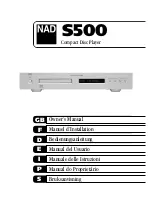
6 - English
KICKSTAND
See Figure 6, page 12.
The planer has been equipped with an automatic pivoting
kickstand that will prevent the blades from contacting the
workbench when not in use. As you begin the planing opera-
tion, the kickstand will automatically retract as it passes over
the edge of the workpiece. When setting the planer down on
the workbench, the kickstand will automatically pivot down
to prevent the blade from making any contact.
WARNING:
Make sure the kickstand operates freely at all times and
that the area surrounding the kickstand is clear of debris.
Failure to do so could result in serious personal injury.
PLANING DEPTH
See Figure 7, page 12.
When you begin planing a rough piece of material, the planer
will only remove the high spots at first. Successive passes
will remove more and more material. By removing no more
than 1/64 in. with each pass, you will achieve the smoothest
finish, even from the roughest workpiece.
Always begin by making test cuts in scrap wood to make
sure that the planer is removing the desired amount of wood.
To set the planing depth:
Remove the battery pack.
Turn the depth adjustment knob clockwise to set the de-
sired depth of cut. The maximum depth of cut is 1/16 in.
NOTE:
Use only detented depth settings. Attempting cuts
with the depth of cut settings between the detented posi-
tions can result in uneven cuts.
NOTE:
To protect the blades during storage, transporting,
etc., turn the depth adjustment knob counterclockwise to
P
on the depth of cut scale to park the blade.
WARNING:
Always clamp the workpiece securely before making
a cut. Work moving during a cut could result in loss of
control of the planer and cause serious injury.
TIPS FOR OPERATING THE PLANER
Clamp the work securely.
Be sure the material to be planed is free of nails, staples,
or screws.
Support the work so that the operation is on your side.
NOTICE:
Planing too fast results in a poor finish and increases chip
build-up in the chip exhaust. Chip build-up restricts air
flow and can cause motor overheating.
ATTACHING THE DUST BAG
See Figure 2, page 11.
Remove the battery pack.
Slide the collar of the dust bag onto the exhaust port.
NOTE:
To remove the dust bag, pull it straight out of the
exhaust port.
NOTICE:
The dust bag fills quickly. Empty it often to prevent dam-
age to the product.
ATTACHING THE PLANER TO A VACUUM
See Figure 3, page 11.
The chip collection system of the planer has a 1-1/4 in. port
for inserting a vacuum hose.
Remove the battery pack.
Remove the dust bag.
Attach a vacuum hose to the left or right chip exhaust.
Set exhaust direction lever to the selected exhaust port.
Connect the vacuum to a power supply.
Turn vacuum on before starting cut.
WARNING:
When the tool is not connected to vacuum, always re-
install the dust bag back onto the tool. Failure to do so
could cause dust or foreign objects to be thrown into your
face or eyes, which could result in possible serious injury.
INSTALLING/REMOVING BATTERY PACK
See Figure 4, page 12.
Lock the switch trigger.
Insert the battery pack into the product as shown.
Make sure the latches on each side of the battery pack
snap into place and the battery pack is secured in the
product before beginning operation.
Depress the latches to remove the battery pack.
For complete charging instructions, see the operator’s manu-
als for your battery pack and charger.
STARTING/STOPPING THE PLANER
See Figure 5, page 12.
To start the planer:
Push the lock-off button from either
side, and then depress the switch trigger.
To stop the planer:
Release the switch trigger.
OPERATION
Содержание P611
Страница 10: ...10 English NOTES ...







































